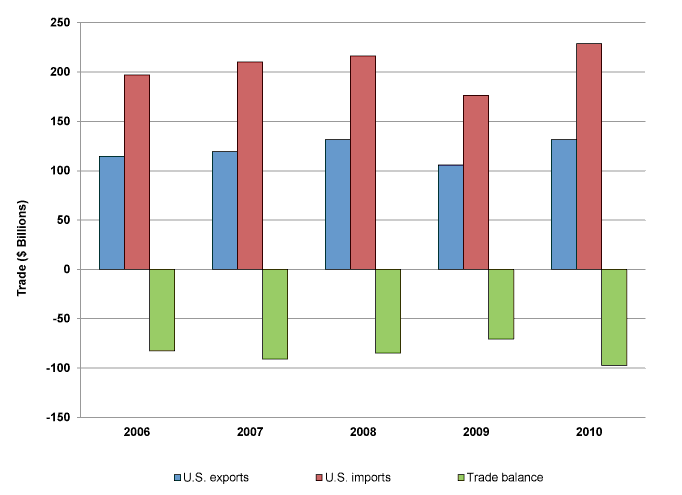View Section in Publication :: Return to Overview

Key Economic Trends
- The U.S. trade deficit with Mexico continued to increase in 2010, rising by $26.6 billion (38 percent) to $97.2 billion. Mexico's business cycle is highly integrated with that of the United States; intrafirm transfers, along with other foreign direct investment and foreign-based manufacturing activity, account for a large share of U.S. merchandise trade with Mexico.
- In 2010, U.S. exports to Mexico rose by $25.9 billion (25 percent) to $131.6 billion, driven in part by a 5 percent expansion of the Mexican economy. This expansion was bolstered by increasing consumer confidence, high petroleum prices, and a resurgence of the export-for-assembly industry. Mexico was the second-largest export destination for U.S. products, exceeded only by Canada.
- U.S. imports from Mexico increased by $52.5 billion (30 percent) to $228.8 billion. Leading U.S. imports from Mexico in 2010 were transportation equipment, energy-related products, and minerals and metals. Mexico was the third-largest source of U.S. imports in 2010, exceeded only by Canada and China.
Trade Shifts from 2009 to 2010
- U.S. trade deficit: Increased by $26.6 billion (38 percent) to $97.2 billion
- U.S. exports: Increased by $25.9 billion (25 percent) to $131.6 billion
- U.S. imports: Increased by $52.5 billion (30 percent) to $228.8 billion
Other Government Resources
- Ministry of the Economy - International Trade Negotiations
- U.S. - Mexico Chamber of Commerce
- U.S. Central Intelligence Agency: World Factbook - Mexico
- U.S. Department of Energy, Energy Information Administration: Country Analysis Brief - Mexico
- U.S. Department of State: Background Note - Mexico
